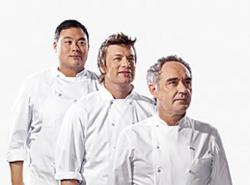Kitchen Gods
June 15, 2010 | 1 min to read

David Chang was asleep in his aisle seat on a recent flight to Melbourne when searing pain jolted him awake: a flight attendant had accidentally spilled boiling water on his arm. That the worst scalding of the Manhattan megachef's life occurred in business class rather than in a busy kitchen was perhaps surprising. But that was nothing compared with what awaited him on the ground. Soon after he landed, news of the accident made the Australian papers and then, thanks to the global hum of diligent foodies at their keyboards, quickly appeared on websites around the world. The shocking headline: "Chef Burned."
It's been a few decades since we started turning cooks into stars, and still the phenomenon continues to grow. These days, the Emerils, Marios and Gordons of the world scarcely need the qualifier chef — they are celebrities, plain and simple. But between the television shows, the food festivals, the Vegas outposts, the spaghetti-sauce labels bearing their names and the fans rabidly tracking everything from new dishes to failed love affairs and, yes, accidental airline injuries, it's easy to overlook the impact that fame has had on the once disparaged profession of cooking. In the Food Network era, the phenomenon of the celebrity chef has utterly transformed the restaurant industry and, in the process, changed the very nature of how we eat.
To read the rest of the story, please go to: Time
